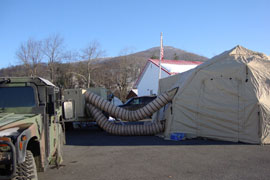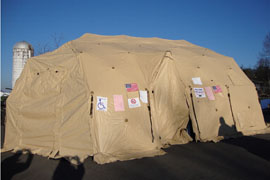Cronkite News has moved to a new home at cronkitenews.azpbs.org. Use this site to search archives from 2011 to May 2015. You can search the new site for current stories.
Despite challenges, state election officials keep calm and carry on
WASHINGTON — With New Jersey still struggling to recover from Hurricane Sandy, voters there were moved to new polling places or forced to fax or email ballots if they could not get to the polls.
The changes sparked thousands of phone calls to a national election hotline from frustrated New Jersey voters. But to Mercer County Board of Elections Chairwoman Joanne Palmucci, things were going as well as could be expected.
“Those (alternate polling sites) are all up and running,” Palmucci said. “We have an exceptional number of provisional ballots, which is to be expected given the circumstances.”
Across the country, a sampling of election officials brought largely the same response Tuesday, despite storm-related disruptions, redistricting, administrative glitches and restrictive new voter laws.
They said things were not bad, considering.
“We prepared for the worst” from Sandy, said Vermont Secretary of State Jim Condos. “We had some power outages right after the hurricane, but those were all restored.”
He said a few “procedural issues” were reported Tuesday, but he characterized them as minor problems that are to be expected.
Vermont voters cast some of the first ballots in the country, with a few polls opening as early as 5 a.m. Tuesday. Condos said voter turnout would probably be around 70 percent, which would be on par with Vermont’s past three general elections.
West Virginia was not so lucky with Sandy, as lingering power outages from last week’s snowstorms forced some counties to use temporary polling locations. A spokesman with the West Virginia Secretary of State’s office said that the National Guard pitched heated tents, which were used as polling locations in Tucker County – but again reported no problems.
In Kansas, voters went to the polls under a new state law that requires photo ID. But the Kansas secretary of state’s office used a $300,000 federal grant to run ads before the election publicizing the new requirement, and Secretary of State Kris Kobach said voters were definitely aware of the change.
“In the Kansas City metro area, not a single person showed up without an ID,” said Kobach, who visited several precincts Tuesday. “I was expecting to see some provisional ballots.”
Kobach said turnout seemed higher than he expected.
“Because we don’t have statewide races or a Senate race, there hasn’t been the statewide get-out-the-vote drives that we have seen in other elections,” Kobach said. “But we are still seeing high turnout. Could be close to 2008, where it was 72 percent.”
The photo ID requirement was not the only change for Kansas voters.
“We just had redistricting, so polling locations changed,” Kobach said. “Everyone was supposed to receive a letter. But that is the only glitch we have seen, with some voters out of habit going to their old polling location.”
In New Jersey, it was not redistricting but Sandy that forced changes.
While some New Jersey voters cast provisional ballots, others faxed in ballots and some scanned and emailed ballots to election officials after the voters were displaced due to storm damage.
Palmucci said that emailed or faxed ballots would be verified like absentee ballots, by following security measures such as matching voter signatures with those already on file with the state.
She conceded that the high number of provisional ballots and electronically submitted ballots will create more work for election workers.
“The vote-counting process and verification of ballots will be longer than usual,” Palmucci said.
While things were hectic on the East Coast, the mood was relaxed in the office of Washington Secretary of State Sam Reed.
There were no polling places to worry about, as Washington and Oregon were once again the only states in the country with vote-by-mail-only systems. In Washington, voters simply had to have their ballot postmarked by Tuesday under the election system the state has used since 2008.
That made it business as usual for the most part for Reed, who administers the state’s elections.
“It’s much better,” Reed said of the Washington system. “It’s easier to focus on what you need to do.”
Officials can begin checking and verifying ballots up to 10 days before Election Day, Reed said, but the votes are not tabulated until 8 p.m. Tuesday.
Reed said most of Colorado and more than a half of California voters already vote by mail, and he hopes more states follow the lead of Oregon and Washington and get rid of polling locations. It would have helped East Coast states that had to adapt in the wake of Sandy.
“The East Coast considers it almost bizarre,” Reed said. “But I hope they would reconsider. They could have avoided a lot of the problems they’re having, with a vote-by-mail system.”










